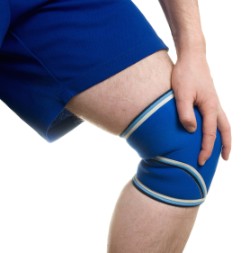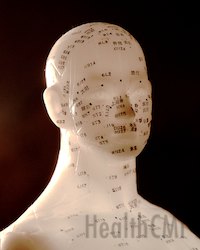Researchers conclude that acupuncture has a significant curative effect on patients with knee osteoarthritis. This condition often involves joint pain, swelling, stiffness, decreased range of motion and the formation of bone spurs. More than 27 million people in the U.S. have osteoarthritis with the knee being one of the most commonly affected areas. In this recent study, the researchers from a community hospital in Beijing treated 200 cases of knee osteoarthritis using acupuncture. The overall effective rate was 98%. 
Traditional Chinese Medicine (TCM) categorizes knee osteoarthritis as a Bi syndrome, which is often caused by a combination of wind, cold and dampness. The 200 patients’ courses of illness ranged from 2 months to 30 years. The researchers divided the cases into three 3 (based on timing of the attack and the pain index) and shapes based on the characteristics of the affected joints. The three phases are the attack phase, recovery phase and stable phase. The five types are: normal type, narrow joint space on the inner side of the knee type, narrow joint space on the outer side of the knee type, bending type with an angle of less than 180 degrees while the knee joint is straightened at normal posture and mixed type with 2 or more aforementioned morphological changes.
For patients in the attack phase, electroacupuncture was combined with the bleeding technique and cupping. For the recovery phase, electroacupuncture was the major treatment aimed primarily at alleviating pain. Bleeding technique and cupping were applied is some cases dependent on the differential diagnosis. For the stable phase, the main task was to restore or improve the muscles of the knee joint and to restore or rebuild the normal functions of muscles and ligament tissues around the knee joint. A special focus on restoring muscle volume and muscle strength of the quadriceps femoris was employed.
During the electroacupuncture treatment, researchers used different needling methods such as local single-needle puncture and local multi-needle puncture. For example, they applied a triple point penetration method, which is a complex acupuncture method combining the traditional triple-puncture and point-penetration methods. Researchers chose from four sets of acupoints during needling, which were the above knee set, below knee set, lateral/medial knee set and the behind the knee set. Acupuncture points UB37 (Yinmen), BL40 (Weizhong), BL56 (Chengjin) and BL57 (Chengshan) were chosen according to individual differential diagnoses. For the normal type, needling was applied to the above knee and below knee sets. For the narrow joint space on the inner side of the knee type, the lateral/medial knee and behind knee sets were chosen. For the narrow joint space on the inner side of the knee type, the behind knee set and customized combinations of individual acupoints were chosen. For the mixed type, acupoints were chosen per differential diagnoses.
Electroacupuncture was primarily applied using low frequency continuous waves. The type of the wave and intensity was chosen dependent upon patient tolerance. Needling was retained for 15-20 minutes for each treatment and was administered three times a week. Ten treatments comprised one course. The period of treatment lasted from 1 to 3 courses. 
The bleeding technique involved the pricking blood and cupping methods. The researchers primarily selected single-use 5ml syringes instead of three-edged needles because the former has a smaller surface area. Blood pricking was applied to EX-LE4 (Neixiyan), EX-LE5 (Waixiyan), BL40 (Weizhong) and alarm points laterally and medially to the knee. Following pricking, cupping was applied to increase the volume of bleeding. Generally, the blood pricking technique was administered every 5-7 days.
Among the 200 patients receiving treatment, 64 patients (32%) fully recovered, 112 patients (56%) showed marked improvements, 20 patients (10%) showed moderate improvements and four patients (2%) showed no improvements. The overall effective rate was 98%. Based on the outcome, the researchers concluded acupuncture combined with the bleeding technique is effective for treating knee osteoarthritis.
Healthcare Medicine Institute, China Desk
Reference:
Shang, Haiyi, Wenyu Geng, and Feng Du. “Treatment of knee osteoarthritis with complex acupuncture therapy.” Journal of Beijing University of Traditional Chinese Medicine (Clinical Medicine) 20.1 (2014): 28-31.


